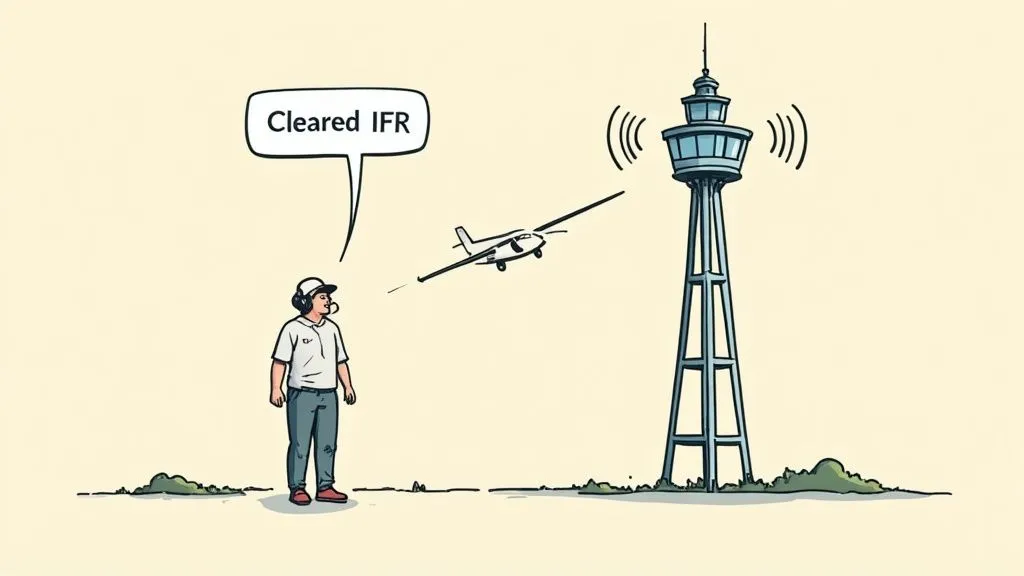Understanding What Makes IFR Flight Plans Essential
Safe and efficient air travel depends significantly on thorough planning, particularly when operating under Instrument Flight Rules (IFR). IFR flight plans are much more than just paperwork; they form the foundation of modern aviation safety. They provide a structured framework for pilots and air traffic controllers to manage flights in all weather conditions. This framework allows for predictable traffic flow, ensuring aircraft maintain safe separation even when visibility is significantly reduced.
Imagine a bustling airport with numerous arrivals and departures happening simultaneously. Without IFR flight plans, managing this complex environment would be incredibly difficult, especially in adverse weather. The plans give controllers vital information about each aircraft’s planned route, altitude, and speed. This allows them to coordinate traffic and avoid conflicts.
The Importance of Predictability in IFR Operations
IFR flight plans establish a shared understanding between pilots and controllers regarding each flight’s path. This shared understanding is essential for maintaining safe separation in instrument meteorological conditions (IMC), where pilots might not be able to see other aircraft. Furthermore, these plans act as a safety net, enabling controllers to anticipate and address potential conflicts proactively.
This proactive approach is particularly critical in congested airspace or during challenging weather. The growing volume of air traffic worldwide further emphasizes the need for effective flight planning. The airline industry has seen significant growth, with 38.9 million flights globally in 2019 alone. This increase in air travel highlights the crucial role of IFR flight plans in maintaining order and safety in an increasingly complex airspace.
(For more detailed statistics, check out: Statista – Airline Industry Statistics)
Real-World Scenarios and Regulatory Framework
Many real-world situations demonstrate the vital role of IFR flight plans in accident prevention. When unexpected weather deteriorates rapidly, a well-defined IFR flight plan allows pilots to transition smoothly to instrument flight and continue safely to their destination or an alternate airport. These plans also provide critical information to controllers, enabling them to reroute traffic and offer support as needed.
IFR flight plans are not simply a tool for managing traffic flow. They are a vital part of the regulatory framework governing aviation safety. Each element of the flight plan, from the aircraft type to the estimated time en route, serves a specific purpose related to safety and air traffic management. Understanding the regulatory requirements behind each component helps pilots appreciate the significant role these plans play in ensuring safe and organized air travel. This understanding is paramount for all IFR pilots navigating today’s complex airspace.
Filing Your IFR Flight Plan Like A Professional
Say goodbye to frustrating flight plan filing and hello to a smoother, more efficient pre-flight experience. This guide will walk you through the process, breaking down the complexities of the ICAO flight plan form with clear, practical advice. Understanding what information Air Traffic Control (ATC) needs and why is key to a hassle-free flight.
Choosing the Right Filing Method
Selecting the right filing method can save you valuable time and ensure a seamless pre-flight process. Your options range from quick electronic submissions to direct phone calls for priority handling.
For routine flights, using an online system like ForeFlight is often the quickest and most convenient method. However, during peak traffic periods or for complex routes, contacting a flight service station directly might be beneficial. This allows for more personalized assistance and potentially faster processing when you need it most.
Read also: How to master flight plan filing
Timing and Amendments: Staying Flexible
Timing is everything when it comes to filing your IFR flight plan. Filing too early can lead to expiration before departure, while filing too late might cause you to miss your planned takeoff time. A good rule of thumb is to file 1-2 hours prior to departure.
Also, understanding how to amend your flight plan is essential for maintaining flexibility. Unforeseen circumstances, like weather changes, unexpected delays, or route revisions, often require adjustments. Knowing the proper amendment procedures ensures a smooth transition and keeps your flight legal and safe.
Avoiding Common Mistakes and Effective Communication
Meticulous attention to detail is crucial during the filing process. Common errors, such as incorrect aircraft information, inaccurate departure times, or missing data, can lead to rejected flight plans or significant delays.
Effective communication with flight service stations is equally important. Clear and concise communication minimizes misunderstandings and ensures your IFR flight plan is processed accurately and efficiently. This proactive approach can save you time and frustration.
Mastering the ICAO Flight Plan Form
Let’s break down the ICAO flight plan form to understand the purpose of each element.
- Aircraft Identification: This requires accurate input of your aircraft type and registration number for proper identification by controllers.
- Route of Flight: Clearly detailing your intended route, including waypoints and altitudes, is crucial for conflict-free flight.
- Departure and Arrival Information: Providing precise airport codes and estimated times is vital for efficient traffic management.
- Other Information: This section includes details such as the number of people on board, fuel endurance, and alternate airport(s) – all essential for safety and contingency planning.
IFR Flight Plan Filing Methods Comparison
| Filing Method | Processing Time | Cost | Best Use Case | Limitations |
|---|---|---|---|---|
| Online (e.g., ForeFlight) | Fastest for routine filings | Varies by service | Routine flights, simple routes | Requires internet access, may be slow during peak periods |
| Flight Service Station (phone) | Can be faster for complex filings | Generally free | Complex routes, priority handling, seeking clarification | May encounter wait times, requires clear communication |
| Direct to ATC (rare) | Fastest in emergencies | N/A | Emergency situations, clearances in flight | Not for routine filings |
Mastering these elements of the IFR flight plan allows you to transition from simply filling out a form to actively contributing to a safer, more efficient flight. This professional approach enhances your credibility and showcases your commitment to responsible flying.
Navigating Complex Airspace With Confidence
Busy airspace can feel overwhelming, but understanding how professional pilots approach complex route planning can increase your confidence. Airline and corporate pilots employ specific strategies to navigate high-density areas efficiently and safely. Let’s explore some of these practical techniques that you can apply to your own IFR flight plans.
Optimizing Flight Path Selection
One key strategy involves optimizing your flight path selection. This goes beyond simply choosing the shortest route. It involves considering ATC expectations, required separation from other aircraft, and potential congestion.
Experienced pilots analyze major route corridors and anticipate traffic flow to select the most efficient path. This proactive planning simplifies the workload for both the pilot and ATC.

For example, when flying into a busy terminal area like New York’s JFK, consider routing slightly offset to a less congested entry point. This can streamline your approach and reduce potential delays. For more information on understanding complex airspace, check out this helpful guide: Understanding complex airspace.
Decision-Making in Congested Airspace
Adaptability is essential in complex airspace. Delays, route changes, and unexpected controller instructions are common. Professional pilots use decision-making frameworks to manage these situations effectively.
They anticipate potential issues and pre-plan alternative routes and altitudes. This allows them to respond quickly and safely to changing conditions.
Understanding traffic complexity is also crucial. The global airline industry’s capacity fluctuates based on market demands. The Spain-UK route, for example, boasts 5.6 million seats this month, significantly exceeding the Mexico-USA route. This high density underscores the importance of robust IFR flight plans. More detailed statistics can be found here: Airline frequency and capacity statistics. IFR procedures ensure aircraft separation and regulatory compliance, even in challenging air traffic environments.
Adapting to Varying Traffic Levels
Finally, recognize that traffic complexity is not static. A route that’s manageable during off-peak hours can become highly congested during peak periods.
Experienced pilots adapt their planning strategies accordingly, considering the time of day, anticipated traffic volume, and potential weather conditions when developing their IFR flight plan. This dynamic approach promotes safer and more efficient travel in all airspace conditions.
Mastering Navigation Equipment For Modern IFR Flying
Going beyond basic IFR flight plans, this section explores maximizing safety and efficiency with modern avionics. We’ll examine the interplay of GPS, VOR, and ILS systems, focusing on practical integration techniques employed by expert IFR pilots. These skills are crucial for navigating the complexities of instrument flight.
Planning for Equipment Failures: Backup Procedures
A critical aspect of IFR flying is anticipating potential equipment malfunctions. This means having effective backup procedures ready to implement under pressure. Before each flight, consider potential problems and develop alternative plans. This proactive approach prevents a difficult situation from escalating into an emergency.
How to master a flight computer
For instance, if your primary GPS navigation fails, knowing how to use VOR navigation as a backup is vital. This ensures you maintain situational awareness and complete your IFR flight plan safely. This is where regular practice and proficiency are essential.
Redundancy Strategies of Professional Pilots
Professional pilots heavily depend on redundancy strategies. These strategies guarantee navigation capability even if primary systems fail. Redundancy can involve backup equipment, alternative navigation methods, or a combination of both.
Pilots must also understand the limitations of each system. This knowledge allows informed decisions when switching between primary and backup systems during an IFR flight plan.
Integrating Advanced and Traditional Navigation Aids
Advanced Flight Management Systems (FMS) provide sophisticated features. However, they still depend on traditional navigation aids like VOR and Distance Measuring Equipment (DME) for data verification. Integrating these systems creates a comprehensive and reliable navigation solution.
This integration is crucial for cross-checking information and ensuring accuracy, especially in challenging terrain or areas with limited GPS coverage. Comparing FMS information with data from VOR/DME stations helps verify your position and the accuracy of your IFR flight plan.
Emerging Technologies and Evolving Standards
Staying current with emerging technologies and evolving IFR navigation standards is essential. New systems and procedures are constantly being developed.
This continuous evolution demands ongoing pilot learning and training. This ensures proficiency and the use of the most current information for safe and efficient IFR flight plan execution. Understanding how these technologies interact with existing systems is crucial for their safe and effective integration into IFR operations.
Smart Weather Planning That Prevents Problems
Weather is a constant companion in aviation. With a solid IFR flight plan, you can minimize its effects and fly safely. This means not only knowing how to read weather reports, but also understanding how to use that information to make informed decisions. Experienced IFR pilots anticipate weather changes; they don’t just react to them.
Decoding TAFs and METARs for Strategic Decisions
Terminal Aerodrome Forecasts (TAFs) and METARs (Meteorological Aerodrome Reports) are your main sources of weather information. Learning to understand these reports is key to spotting developing weather patterns that could impact your flight. This includes understanding current conditions and predicted trends.
For example, a TAF showing decreasing ceiling and visibility suggests worsening conditions. This data is crucial for making go/no-go decisions and choosing appropriate alternate airports.
Choosing Alternate Airports: Your Backup Plan
Choosing suitable alternate airports is crucial for safe IFR flight planning. A good alternate isn’t just any airport; it’s one that provides a realistic backup if your destination’s weather deteriorates.
When selecting an alternate airport, consider factors like runway length, available instrument approaches, and the overall weather forecast for the alternate. A solid backup plan greatly reduces the risks from unexpected weather changes.
Building Flexibility into Your IFR Flight Plan
Flexibility is essential in IFR flying. Weather can change quickly, so your IFR flight plan must be adaptable. This means having plans for potential delays, reroutes, and diversions.
Treat your flight plan as a living document, ready to be adjusted as needed. This proactive approach lets you adapt to changing conditions without compromising safety.
Fuel Planning for Weather Contingencies
IFR fuel planning accounts for weather. Calculating fuel for your planned route isn’t enough. You must also account for potential diversions and holding patterns.
This includes adding fuel reserves for unforeseen situations, like holding at your destination due to low visibility. Sufficient fuel ensures you can reach your alternate or even an alternate for your alternate if necessary.
Understanding Regulatory Requirements for Alternates
Understanding the regulations for alternate airports is also essential. These requirements vary depending on the flight operation and the forecast weather at your destination.
Familiarize yourself with the specific rules regarding alternate selection and fuel requirements. This knowledge ensures a safe and legal IFR flight plan. (The following table provides a general overview and should not replace consulting official resources for specific requirements.)
IFR Weather Minimums and Alternate Requirements
| Operation Type | Ceiling Minimum | Visibility Minimum | Alternate Required | Fuel Requirements |
|---|---|---|---|---|
| Non-Precision Approach | 600 feet AGL | 2 statute miles | If descent from MEA/MDA to landing cannot be made in VMC | Destination + Alternate + 45-minute reserve |
| Precision Approach | 200 feet AGL | 1/2 statute mile | If descent from MEA/MDA to landing cannot be made in VMC | Destination + Alternate + 45-minute reserve |
This table highlights the general weather minimums for different IFR approaches, illustrating when alternates are required and the importance of adequate fuel reserves. Always refer to current regulations and resources for the most up-to-date information.
Route Optimization For Increasing Air Traffic Demands
With the continued growth of air traffic, efficient route planning for IFR flight plan operations is more critical than ever. Pilots must adapt their planning to accommodate increased traffic density while maintaining the highest safety standards. This necessitates a strategic approach, moving beyond simply plotting a course to selecting the most effective and efficient path.
Fuel Efficiency and Environmental Impact
Fuel efficiency is a major consideration in route optimization. Selecting flight paths that minimize distance and optimize altitude can significantly reduce operating costs. This not only benefits an airline’s or operator’s budget, but also lessens the environmental footprint of aviation.
Factors such as prevailing winds and weather patterns also play a critical role in fuel-efficient route selection. Harnessing tailwinds, for example, can drastically reduce flight time and fuel consumption. Integrating weather data into route planning is key for both cost savings and environmental responsibility.
Minimizing Delays Through Strategic Routing
Beyond fuel efficiency, minimizing delays is a primary goal of IFR flight plan optimization. Analyzing current traffic patterns and understanding controller preferences enables pilots to choose routes less susceptible to congestion. This involves considering factors like departure and arrival times, known traffic hotspots, and common routing practices.
If a particular airway is known to be heavily congested during specific times, selecting an alternative route can save valuable time and avoid delays. Proactive planning and anticipating potential bottlenecks are crucial components of efficient routing.
Check out our guide on cross-country flight planning.
Anticipating Controller Preferences
Anticipating controller routing preferences is another important strategy. Experienced pilots recognize that controllers often favor certain routes based on traffic flow and airspace management. Integrating these preferences into an IFR flight plan increases the likelihood of a pilot receiving their desired route.

However, having backup plans is equally crucial. Primary routes can become congested, requiring controllers to reroute aircraft due to unforeseen circumstances. A well-defined backup route ensures flights stay on schedule even when adjustments to the initial plan are necessary.
Staying Ahead of Traffic Growth
Airlines and private operators are employing advanced planning techniques to manage growing air traffic demands. These strategies include using sophisticated weather forecasting tools, analyzing historical traffic data, and staying informed about controller routing practices.
In 2024, global air passenger demand reached record highs. International traffic even exceeded 2019 pre-pandemic levels by 0.5%, highlighting the aviation industry’s resilience. The Asia Pacific region experienced substantial growth, with a 16.9% increase in Revenue Passenger Kilometers year over year. Efficient flight planning, particularly for IFR routes, becomes even more essential to handle this increased volume. This proactive, adaptable approach allows operators to maintain efficiency and minimize delays in the face of rising air traffic.
For more information, see: Global air traffic data
Key Takeaways For IFR Flight Plan Success
Building a solid IFR flight plan involves much more than simply completing a form. It’s about crafting a thorough strategy that incorporates weather analysis, route optimization, and contingency planning. This section distills key lessons from experienced pilots into actionable strategies you can use right away.
Pre-Flight Preparation: Setting Yourself Up For Success
A successful IFR flight starts with careful pre-flight preparation. This includes thoroughly reviewing weather information, choosing suitable alternate airports, and verifying the accuracy of your filed IFR flight plan. This proactive approach helps address potential issues before they impact your flight, resulting in a smoother and safer experience.
Weather Analysis: Closely examine weather forecasts, including TAFs and METARs, to pinpoint potential hazards and make well-informed go/no-go decisions.
Alternate Planning: Select alternate airports that offer realistic backup options should weather conditions deteriorate or other unexpected events occur.
Flight Plan Verification: Double-check every detail of your IFR flight plan to confirm accuracy and completeness. This will help avoid delays or unexpected rerouting.
In-Flight Decision-Making: Adapting to Changing Conditions
Adaptability is crucial in IFR flying. Weather conditions and air traffic situations can change rapidly, requiring pilots to make prompt, informed decisions.
Dynamic Route Adjustments: Be ready to adjust your planned route in response to evolving weather patterns, traffic congestion, or Air Traffic Control (ATC) instructions.
Contingency Planning: Have backup plans in place to address potential equipment malfunctions or unforeseen delays.
Effective Communication: Maintain clear and concise communication with ATC. This ensures a shared understanding of your intentions and allows you to receive timely assistance.
Building Proficiency: The Path to Mastery
Becoming a proficient IFR pilot is an ongoing process. Consistent practice, continuous learning, and a commitment to improvement are vital for mastering these skills.
Regular Practice: Stay proficient in IFR procedures through regular practice in both simulated and real-world flying environments.
Ongoing Learning: Keep current with the latest regulations, procedures, and technologies related to IFR flight planning.
Seek Feedback: Request feedback from seasoned pilots and certified flight instructors (CFIs) to identify areas for improvement and refine your techniques.
Checklists and Benchmarks: Measuring Your Progress
Tracking your progress is essential for skill development. Utilizing checklists and defining realistic benchmarks can help you measure improvement over time.
Pre-Flight Checklist: Create a thorough checklist to ensure all essential pre-flight steps are completed before each IFR flight.
In-Flight Checklist: Use checklists during flight to manage critical tasks and maintain consistent adherence to procedures.
Post-Flight Review: Conduct post-flight reviews to analyze your performance and identify areas where you can further refine your skills.
Final Thoughts
Concentrating on these key takeaways and consistently implementing these practical strategies will help you build confidence and competence as an IFR pilot. This professional approach ensures safer, more efficient flights and contributes to a higher level of safety and professionalism in aviation.
Remember, mastering an IFR flight plan isn’t just about navigating from point A to point B; it’s about meticulous planning, adapting to the unexpected, and flying with confidence and precision.
Recent Posts
FAA MOSAIC Final Rule: What Pilots, Manufacturers, and the Aviation Community Need to Know
Learn how the FAA’s MOSAIC final rule revolutionizes Light-Sport Aircraft certification, expands Sport Pilot privileges, and reshapes general aviation. See what’s changing, when it takes effect,...
Student Pilot Insurance: Essential Coverage for Aspiring Flyers
Discover how student pilot insurance can protect your flying dreams. Get expert tips and coverage options to ensure your safety and peace of mind.


